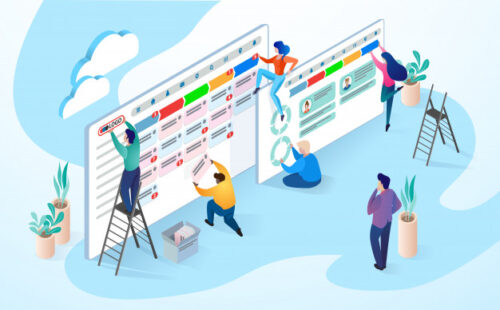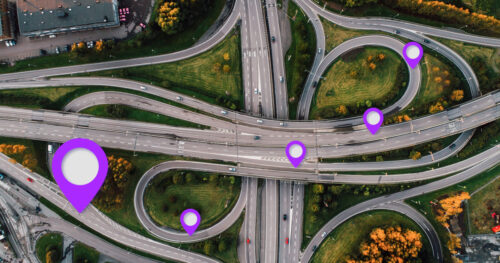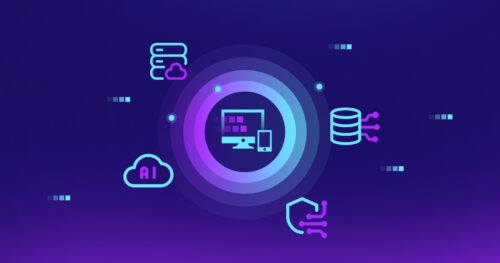A lot of companies don’t have a clear understanding of how to build their cloud strategy and get significant value and high ROI from their cloud transformation. That’s why they get stuck at some point. Having already transferred more than 50% of their data environment to the cloud, they still don’t see adoption and value at scale. The reasons for this, McKinsey suggests, include failing to leverage high-value use cases on the cloud and spending too much on building the cloud foundation. DigitalMara has collected some practical information about cloud platforms and made a comparative analysis.
More and more companies are choosing to migrate their software, applications and services to the cloud to become more agile, adaptive and responsive. However, cloud transformation needs to be envisioned from the business side and not just IT. McKinsey estimates the potential global value of cloud on the level of $3 trillion by 2030. According to their study, successful transformation requires simultaneously executing three objectives:
- Defining strategy and managing for value,
- Driving business domain adoption,
- Building foundational capabilities.
Cloud platforms
Gartner predicts that by 2026, 75% of organizations will adopt a digital transformation based on cloud as the fundamental platform; accordingly, worldwide public cloud end-user spending should reach over $700 billion in 2024. The largest segments by end-user spending are SaaS and IaaS.
Compared to the on-premises environment, clouds offer enhanced stability, flexibility, scalability, and resiliency as well as faster recovery time. Cloud services offer their customers various resources, including databases, servers, analytics, storage, intelligence, networking, and software, as well as access to them at any time from anywhere. There is no need for companies to build their own computing infrastructure or data centers; they need only to pay for use of the service.
Functions
Cloud platforms provide a variety of functions, including:
- resources such as servers, storage, and networking infrastructure,
- a platform for developing, testing, and deploying software applications,
- software applications that can be accessed over the internet,
- scalable and secure data storage solutions,
- backup and disaster recovery services to prevent data loss or system failure,
- analytics tools to gain insights from their data,
- tools and services to connect and manage IoT devices and data,
- tools and services to support DevOps practices,
- AI and ML tools for tasks such automation and data processing,
- security features such as encryption, access controls, and threat detection to protect data and applications,
- content management systems to create, manage, and publish digital content,
- tools and services to develop, test and deploy mobile and web apps,
- CRM solutions to manage customer interactions and relationships, and
- collaboration tools and networking.
Cloud and security
Responsibility for cloud security is shared between the cloud provider and the customer. The provider protects the infrastructure, network and data in transit and at rest, and is responsible for physical security of the data centers and compliance with modern regulations. Meanwhile, the customer manages users and their access and is responsible for application security and data protection.
In practice, a cloud platform’s security measures will include data encryption, multi-factor authentication and role-based access control, firewalls, intrusion detection and prevention systems compliance with GDPR, HIPAA, PCI DSS and other standards, incident response, and regular security audits and assessments. All this is to ensure proper data processing and storage, to provide access to the data of only authorized users, identify and eliminate any vulnerabilities in the systems, prevent data loss, and counter cyber threats.
Platforms comparison
There are a bunch of service providers in the market. The most widely used are these three: Microsoft Azure, Amazon Web Services (AWS), and Google Cloud Platform (GCP). Among the more niche are Oracle Cloud Infrastructure, IBM Cloud, SAP Cloud, Salesforce Cloud and VMWare Cloud.
When choosing a cloud platform, it’s important to consider the following factors:
- Business needs,
- Cost of services,
- Performance, throughput, and availability,
- Ease of integration with existing systems and other services,
- Reliable support and clear documentation, and
- Robust security, including encryption, access control, and compliance.
| Cloud platform | AWS | Google Cloud | Azure | Oracle Cloud Infrastructure | IBM Cloud | SAP Cloud | Salesforce Cloud | VMware Cloud |
| Owner | Amazon | Microsoft | Oracle | IBM | SAP | Salesforce | VMWare | |
| Launch year | 2006 | 2008 | 2010 | 2016 | 2011 | 2012 | 2009 | 2009 |
| Geographical regions | 32 | 36 | 60+ | 36 | 9 | 27 | 11 | 21 |
| Availability zones | 102 | 109 | 113 | 46 | 27 | – | – | 68 |
| Pricing | – Pay-as-you-go – Free Tiers – Always free products | – Pay-as-you-go – Free Tiers – $300 in free credits for new customers – 20+ free products | – Pay-as-you-go – Free Tiers – Always free products | From 54$ per month | – Pay-as-you-go only for US – 1-year subscription – 3-year subscription | Pricing upon request | From 25$ per month | – On-demand – 1-year or 3-year standard subscription – 1-year or 3-year flexible subscription |
| Cloud products | – Compute – Storage – Database – Networking & Content Delivery – Analytics – Machine Learning – Security – Identity & Compliance – Blockchain – IoT | – AI & Machine Learning – API Management – Compute – Containers – Data – Analytics – Databases – Developer tools – Financial services – Healthcare and Life Sciences – Hybrid & Multicloud – IoT – Management tools – Media & Gaming – Migration – Networking -Operations – Security & Identity – Serverless Computing – Storage – Web3 | – AI & Machine Learning – Analytics – Compute – Containers – Databases – Developer tools – DevOps – Hybrid & Multicloud – Identity – Integration – IoT – Management & Governance – Media – Migration – Mixed reality – Mobile – Networking – Security – Storage – Virtual desktop infrastructure – Web | – Analytics & BI – Big Data & Data Lake – Compute – Containers & Functions – Cost management &Governance – Database services – Database tools – Developer services – Distributed cloud – Integration – Machine Learning & AI – Multicloud – Networking – Observability & Management – Security – Storage – VMware | – AI & Machine Learning – Analytics – Automation – Blockchain – Compute – Containers – Databases – Developer tools – Integration – Logging & monitoring – Networking – Security – Storage | – SAP Analytics cloud – SAP Ariba – SAP Business ByDesign – SAP Cloud ALM – SAP Concur – SAP customer experience – SAP Data Warehouse cloud – SAP Digital manufacturing cloud – SAP Fieldglass – SAP HANA Cloud – SAP HANA Enterprise Cloud – SAP Integrated business planning – SAP Intelligent asset management – SAP Logistics business network – SAP SuccessFactors – SAP S/4HANA Cloud | – Sales cloud – Service cloud – Data cloud – Marketing cloud – Experience cloud – Commerce cloud – Community cloud – Analytics cloud – Industry cloud | – App Platform – Cloud & Edge – Anywhere workspace – Security & Networking – Emerging technologies – Support products |
| Security standards and compliance certifications | Supports 143 | Supports 164 | Supports 100+ | Supports 33 | Supports 42 | Supports 21 | Supports 42 | Supports 19 |
| Compute engine | Elastic Compute Cloud (EC2) | Configurable Virtual Machines | Virtual Machine | Virtual Machine | Code Engine | Virtual Machine | AMD EPYC™ Processor-powered N2D machine types on Google Compute Engine | VMware Engine based on Google Cloud |
Future of clouds
Cloud technology continues to evolve. We note some potential trends:
- Multi-cloud approach
Multi-cloud is gaining more popularity, as companies prefer not to tie themselves to only one cloud provider. This approach minimizes the problems that arise when conditions change within the cloud provider or application support is terminated. A multi-cloud approach decreases the likelihood of system errors or downtime leading to critical failures of business operations. Furthermore, with container-based architecture, applications can be quickly migrated to new platforms if necessary. However, managing multiple cloud platforms can be complex and requires careful planning and coordination.
- AI- and ML-powered clouds
Cloud providers apply AI and ML technologies to their services, making them more powerful and efficient. Mainly this involves automation, performance and security — for example, for provisioning and managing cloud resources, optimizing workload placement and resource allocation to ensure that workloads are running on the most appropriate cloud resources. Also, these technologies improve security by detecting and responding to threats in real-time, analyzing network traffic to identify anomalous behavior that may indicate a security threat.
- Industry cloud platforms
Industry clouds are tailored to meet the unique needs and requirements of a specific industry or vertical, such as healthcare, finance, manufacturing, retail, energy, government, and others. This may involve specific workflows, processes, and data management needs. Cloud providers adapt their solutions and offer industry-specific applications, tools, and services that are pre-configured to meet the needs of the industry. Companies can benefit from improved efficiency, better data management, and compliance with industry regulations, so they can focus on their core business functions.
Summary
You can benefit from cloud application development thanks to many factors. For example, access to the latest cloud technologies and infrastructure, reduced development costs and time-to-market, increased scalability and flexibility, and improved app security and data protection.
At DigitalMara we have extensive experience working with major cloud platforms, aka Microsoft Azure, Google Cloud Platform and AWS. We know how to use their capabilities and get the most from cloud environments. In particular, our team can build cloud solutions from scratch, migrate your legacy system into the cloud, and create cloud integrations.


































